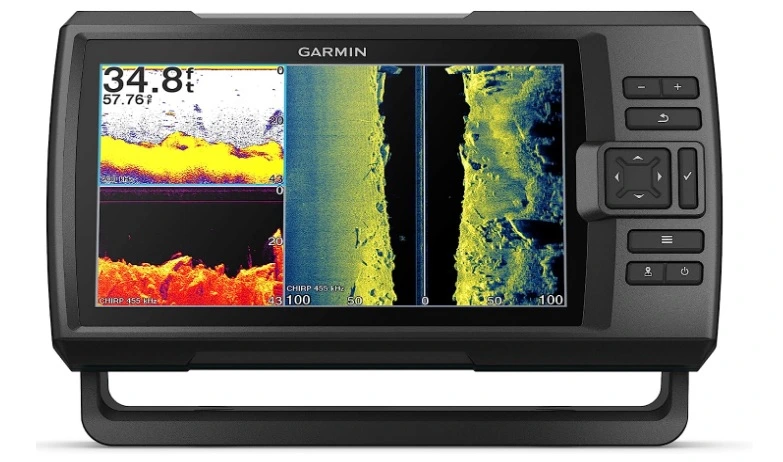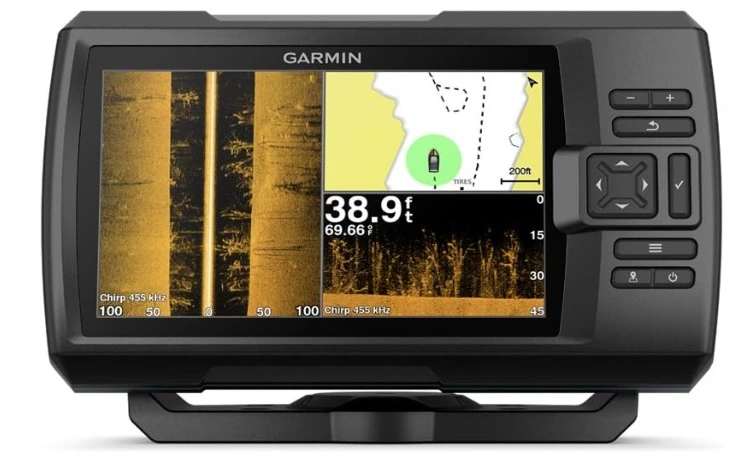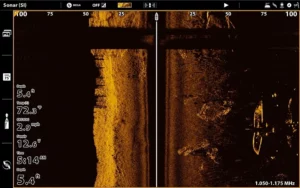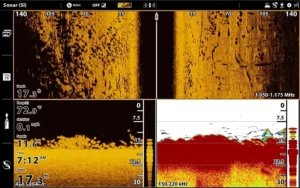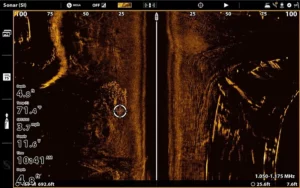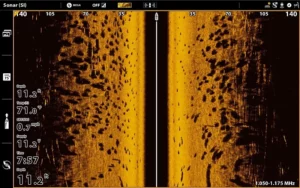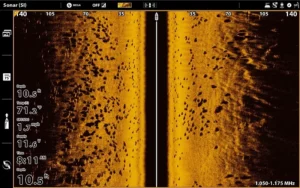Side Imaging: Garmin Fish Finders Reviews & Tips in 2024
Garmin’s Fish Finders with Side Imaging, also known as SideVü, are a revolutionary tool in marine electronics for anglers and marine enthusiasts.
Side imaging, synonymous with SideVü, side scan sonar, sidescan sonar, and side-imaging sonar, revolutionizes conventional fish-finding techniques, enabling a meticulous mapping of the underwater topography.
This advanced Ultra High-Definition SideVü Scanning sonar system amplifies the angler’s ability to discern underwater structures, contours, and habitats, facilitating a nuanced understanding of the aquatic environment. Employing a sophisticated transducer, these fish finders transmit lateral sound waves that meticulously survey and represent the sea floor’s vast expanses, enhancing the accuracy of depth detection and fish location.
Embedded within the Fish Finder, the GPS integration, paired with high-resolution display features, augments navigational precision, streamlining the angling process. The synthesized technological elements contribute toward optimizing the overall fishing strategy, refining the exploration and navigation of both freshwater and saltwater bodies.
In this article, we will see two Garmin Side Imaging Reviews, Sidevu Frequency, Sidevu Images, Sidevu vs. Clearvu, Features to Consider, Garmin Fish Finder Best Settings, Garmin Sidevu vs. Humminbird Side Imaging, Garmin Sidevu Problems, and FAQs.
Let’s kick-start the Best Side Scan Fish Finder Review now.
Review of Garmin Sidevu Sonars of 2024
Garmin Striker Vivid 9sv, Easy-to-Use 5-inch Color Fishfinder and Sonar Transducer
The Garmin Striker Vivid 9sv is an innovative and robust fishfinding tool that strikes the perfect balance between form and function. As a brand, Garmin has consistently delivered high-quality marine electronics, and this model is no exception. One of the major highlights of this fishfinder is its 9-inch color display, which showcases vivid scanning sonar color palettes. These palettes make it incredibly easy to distinguish between fish and structures underneath the water, ensuring precision in fishing endeavors.
Another noteworthy feature is its support for Garmin CHIRP traditional sonar, in addition to CHIRP ClearVü and CHIRP SideVü scanning sonars. This combination ensures an all-encompassing view below the water surface, provided you have a compatible transducer. For those keen on navigation, the device’s high-sensitivity GPS is a godsend. It allows users to mark waypoints, chart routes, and even monitor the speed of their boat.
Modern technology integration is evident with the inclusion of Wi-Fi connectivity. This allows seamless connection to the ActiveCaptain app on compatible smartphones. Whether it’s transferring waypoints, receiving smart notifications, or accessing the Garmin Quickdraw Community, the app-driven features cater to contemporary needs.
Its ClearVü feature, in particular, gives a crystal-clear view of the underwater structure. The Quickdraw Contours mapping also stands out, especially for those who like to customize their fishing maps.
Pros:
- 9-inch Vivid Display: Clear and colorful visualization.
- Advanced Sonar Capabilities: Supports Garmin CHIRP, ClearVü, and SideVü.
- High-sensitivity GPS: Easy waypoint marking, route creation, and boat speed monitoring.
- Quickdraw Contours Mapping: Customizable fishing maps.
- Wi-Fi Connectivity: Seamless integration with the ActiveCaptain app.
- Value for Money: Premium features at a budget-friendly price.
Cons:
- Screen Size: Might be small for users accustomed to larger displays.
- Compatibility: Requires a compatible transducer for full sonar features.
Garmin Striker 7SV with Transducer, 7" GPS Fishfinder with Chirp Traditional, ClearVu and SideVu
The Garmin Striker 7SV redefines what one should expect from a fishfinder, with a plethora of high-end features packed into a compact unit. Garnering attention right off the bat is the 7-inch WVGA color display, ensuring excellent clarity even in direct sunlight. This vivid display, combined with an intuitive user interface, makes for a user-friendly experience, allowing fishermen to focus on what they love: catching fish.
Diving deeper into its capabilities, the Striker 7SV boasts CHIRP traditional sonar, CHIRP ClearVü, and CHIRP SideVü scanning sonars. The inclusion of these technologies ensures near-photographic imagery of the underwater environment. Whether it’s discerning fish from submerged structures or getting a detailed view of the side terrains, the device’s sonar capabilities are second to none.
The integrated Quickdraw Contours mapping software is another feather in its cap, enabling users to create custom maps with 1’ contours for vast areas up to 2 million acres. This community-driven feature ensures that fishermen have access to the most detailed and recent underwater maps.
In today’s connected world, the Striker 7SV doesn’t disappoint. With built-in Wi-Fi, users can seamlessly integrate with the ActiveCaptain app, facilitating smart notifications and access to a treasure trove of data from the Quickdraw Contours Community.
Navigational features are robust as well, with a high-sensitivity GPS module that allows for precise marking of waypoints, route creation, and real-time boat speed monitoring. Such features are invaluable, especially when retracing productive fishing spots or navigating to specific landmarks.
Pros
- Exceptional Imaging: Features both down and side imaging for an unparalleled underwater perspective.
- Ease of Use: Simple, intuitive interface coupled with a bright screen.
- Cost-Effective: Delivers advanced features, notably side imaging, at a competitive price point.
- Versatility: Suitable for multiple boat points, from the helm to the trolling motor.
- Enhanced Fishing Success: Ultra-clear down imaging can even track individual fish, significantly boosting the catch rate.
- Dual Usage Satisfaction: Satisfactory performance led to subsequent purchases for other boat locations.
Cons
- Lack of Chart Plotter: Although equipped with GPS for marking waypoints, it misses out on a built-in chart plotter, necessitating the use of external apps or devices for detailed navigation.
Garmin Sidevu Frequency
The echomap, a fishing equipment that’s gained popularity among anglers, uses two main frequency settings – 800kHz and 455. In freshwater environments, these frequencies play distinct roles.
Let’s talk about how these frequencies differ in terms of clarity and range when used in an echomap unit.
According to Lowrance, the 455 beam has a wider angle. This makes it perfect for searching in a larger area. In contrast, the 800kHz provides a clearer, more detailed view. This distinction is especially noticeable in both side vu and down vu modes on the echomap.
Switching between these frequencies might be challenging for beginners. When using the demo mode of echomap chirp 73sv, it’s not easy to switch from 455 to 800.
But, it’s essential to note that the demo might be more aligned to the 455 setting. Using the 800kHz frequency can lead to washed-out images in shallow waters. This happens when the gain or sensitivity is too high. This means tweaking the settings is crucial for optimal visualization.
When choosing a frequency for fishing, consider the depth and what level of detail you prefer. A few people changed from Lowrance LSS2 to Garmin 93sv and saw that the 455 wasn’t clear at 800kHz. In depths ranging from 5 to 50 feet, the 800kHz offered superior detail.
In conclusion, the 455 kHz is the best frequency for side imaging, good for broad searches. Yet, the 800kHz is better for detailed fishing expeditions. Like any tools, the best frequency depends on the angler’s needs and the conditions.
Garmin Sidevu Images
Garmin Sidevu Vs Clearvu
With advanced navigation and fish-finding technology, it offers two distinct sonar imaging techniques: Clearvu and Sidevu. Both play a significant role in improving the fishing and navigation experience, but each has its specialties. Let’s delve into their specifics to understand the differences and how they can be best utilized.
Sidevu
Definition: The Garmin Sidevu offers a wide-angle view of what’s on the sides of your boat. Think of it like having two cameras pointed outward, scanning the waters on either side.
Advantages:
- Broad Coverage: Sidevu scans large areas on both sides of the boat, helping you cover more water in less time.
- Structure Identification: It excels at showing the contours of the land, such as drop-offs, banks, rock formations, and other submerged structures.
- Shadow Detailing: Sidevu uses shadows to define structures. For instance, a tall rock or shipwreck will cast a shadow, indicating its size and shape.
- Use Case: Best for anglers or sailors who want to understand the layout of the waters around them. Whether you’re trying to locate a good fishing spot, understand the water terrain, or navigate safely, Sidevu offers a panoramic view of your surroundings.

Clearvu
Definition: Garmin Clearvu provides a near-photographic image of what’s directly beneath your boat. It’s a high-frequency scanning sonar that gives detailed representations of structures, submerged objects, and even fish.
Advantages:
- Highly Detailed Images: Clearvu produces sharp, detailed images. This makes it easier to identify individual objects, fish, or specific bottom structures underneath the boat.
- Depth Clarity: It’s particularly effective in providing clear images in deeper waters. Whether you’re in freshwater or saltwater, Clearvu offers clarity that rivals traditional sonar.
- Target Separation: If there are multiple targets underneath, such as a school of fish, Clearvu can separate and identify them individually.
- Use Case: Ideal for those wanting to understand what’s directly beneath them. Whether it’s a sunken ship, a school of fish, or underwater vegetation, Clearvu brings it into sharp focus.

Choosing between Clearvu and Sidevu depends on what you need. If you’re keen on understanding the direct bottom beneath your vessel, Clearvu is the way to go. However, if a comprehensive scan of the surroundings is what you’re after, Sidevu offers an unparalleled view. Many modern Garmin units come with both capabilities, allowing users to switch as per the situation and requirement.
Features to Consider When Choosing a Side Imaging Fish Finder
When looking for a suitable fish finder with side-imaging sonar, the two essential factors to consider are the imaging quality and the device’s overall functionality. Leading brands like Garmin, Humminbird, and Lowrance offer devices with clear resolution, ensuring a detailed view beneath the water.
Type(s) of Imaging
The type of imaging, whether side or down, plays a crucial role in the device’s utility. Transducers, such as the GT52 and GT54 UHD, further enhance this imagery, providing clearer views of underwater structures and fish.
Importance of Display Size
Display size is another crucial factor, with larger screens often offering a more detailed view. For instance, models like the Garmin 93sv and 73sv are highly regarded for their screen clarity and built-in map features.
Pricing and Value
Price is an essential consideration, but it’s equally important to ensure you’re getting good value. Look out for sales and discounts on models known for their durability and high performance.
Warranties and Customer Service
Pay attention to warranties and customer service, as these can be invaluable in the long run. Brands like Raymarine and Simrad, while not as frequently mentioned in the inputs, are also noteworthy contenders in the market.
Additional Features to Consider
A few other features to keep in mind include battery life, the device’s waterproof rating, its depth capability, and any available software updates. With technology constantly advancing, it’s also worth checking if the fish finder can integrate with mobile apps or if it offers wireless connectivity.
Informed Decisions for Better Fishing
By keeping all these points in mind and staying updated with product reviews and brand reputations, you can make an informed decision and choose the best fish finder tailored to your fishing needs.
Garmin: Best settings for SideVu and DownVu
When adjusting the settings for SideVu and DownVu on Garmin:
- Update Software: Ensure the latest software is installed. New updates may provide enhancements for a better experience.
- Default Settings: Start by resetting your device to its default settings. This gives you a clean slate, removing any prior configurations that might affect performance.
- Sidescan Range: Adjust the sidescan range based on your depth. A common recommendation is 3-5 times the depth, but this can be tailored based on what you’re looking to identify underwater and the water conditions.
- Gain and Contrast: Modify the gain (brightness) and contrast settings according to your needs. A higher gain might introduce noise, while too low might make you miss targets. Contrast will help in differentiating targets on the screen.
- Utilize CHIRP: If your Garmin supports CHIRP, it’s recommended to keep it on. CHIRP technology generally enhances sonar readings.
- Frequency Selection: Choose your frequency based on your needs. Lower frequencies offer a wider range but less detail, while higher frequencies provide more detail over a shorter range.
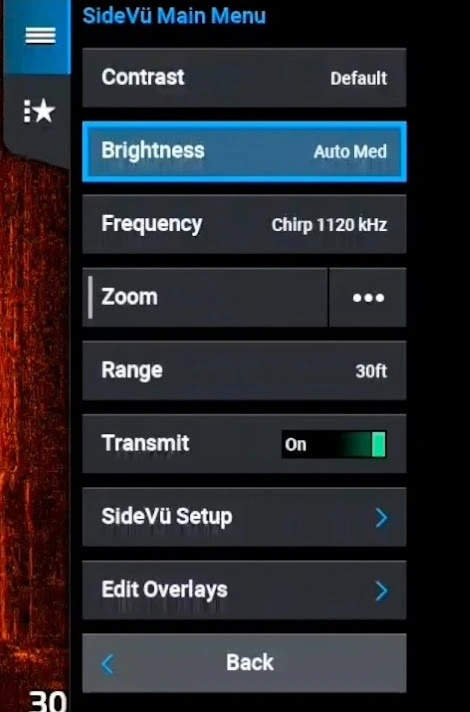
Garmin Sidevu Vs Humminbird Side Imaging
In our comprehensive comparison of Garmin SideVu and Humminbird Side Imaging technologies, we dissect the nuances that set these leading sonar imaging solutions apart. By delving into the specifics, our table highlights the unique features and performance metrics of each, ensuring anglers can make an informed decision based on precision, clarity, and overall efficiency in underwater exploration.
Navigation Excellent, especially with HomePort for effective waypoint management. Less intuitive compared to Garmin, uses HumminbirdPC which is less visual.
Overall Performance Strong in navigation, waypoint management, and user interface. SI quality is good but slightly inferior to top-end Humminbird models. Strong in SI quality, especially in higher-end models. Interface and navigation are less user-friendly than Garmin.
Price Point Competitive, with the GT54 being a budget-friendly option. Varies across models; higher-end models like SOLIX and APEX are more expensive.
Recommended For Users valuing a balance of good SI quality, excellent navigation, and user experience. Users prioritizing top-notch SI quality and willing to invest in higher-end models.
Side Imaging (SI) Good quality with GT56, slightly less impressive with GT54. Close in quality to Humminbird Helix. Superior in SOLIX and APEX models. Helix has slightly lower quality than SOLIX/APEX but still competitive.
Transducer Options GT54 is more affordable but GT56 offers noticeably better performance. Different models use different transducers; higher-end models offer better imaging.
User Interface Highly praised for its responsive touch screen and intuitive menu setup. Less user-friendly compared to Garmin, especially in the Helix series.
Waypoint Management More efficient and user-friendly. Less convenient and visually intuitive.
Garmin Sidevu Problems: Tips and Tricks
Understanding Garmin ECHOMAP Plus 93SV: Features, Common Problems, and Solutions
Garmin is well-known for its leading GPS and sonar technology. Their Garmin Echomap Plus 93sv is a top-tier product offering advanced features for those interested in marine navigation.
While it stands out for its quality, users may experience some challenges. Here’s a quick guide to address some of these problems.
1. Unsupported Transducer Problem:
- If your device displays messages about an unsupported or disconnected transducer, first check all power cables for signs of damage or corrosion.
- If corrosion is found, a mix of water and vinegar can help clean it.
2.Image Clarity Issues:
- Unclear images can be due to air bubbles around the transducer, the boat’s speed, or water conditions.
- Check the transducer for damage and ensure its connections are tight.
- Change the device’s frequency channel if there’s interference from other devices.
- Consider slowing down the boat or choosing clearer waters for better image clarity.
3. Sonar Settings:
- Adjusting the sonar settings can help get better readings. This can be done by changing the frequency based on water conditions.
- Consult the device’s manual (available on Garmin’s website) for detailed guidance.
4. Transducer Troubleshooting:
- The transducer’s position can affect the quality of sonar readings. If you’re losing readings at high speeds, consider adjusting its position.
5. Check the transducer’s cable for damage.
- If you face consistent issues, reach out to Garmin’s customer support or visit a local dealer for assistance.
- For those with devices under warranty, it might be beneficial to check the warranty guidelines as some repairs or part replacements might be covered.
FAQs: Side Imaging and Related Concepts
Gary Burrell
Born in 1989, Gary Burrell is an Electrical Engineering graduate from the University of Tennessee. With 20+ years of experience, he has transitioned from engineering roles to becoming the Chief Content Editor. Gary’s unique blend of technical knowledge and editorial expertise has made him an essential figure in content creation, ensuring clarity and accuracy. His journey from an engineer to an editor showcases his adaptability and commitment to continuous learning.

